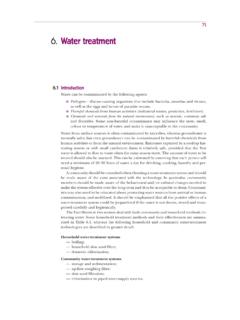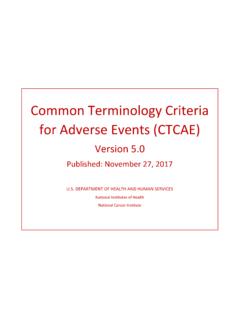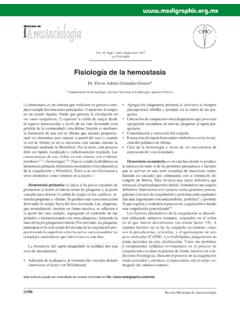Transcription of Guidelines: Diagnosis and Management of Thrombosis with ...
1 COVID-19 VACCINES TTS GUIDANCE 11 AUG 2021 1 guidelines : Diagnosis and Management of Thrombosis with Thrombocytopenia Syndrome (TTS) following Adenovirus Vectored COVID-19 Vaccinations 11 August 2021 Introduction Rare cases of blood clots with low platelets after receipt of adenovirus vector COVID-19 vaccines (AstraZeneca (AZ) and Johnson & Johnson (J&J) COVID-19 vaccines) have been reported and are referred to as Thrombosis with Thrombocytopenia Syndrome (TTS). Although initial media reports described older females to be at higher risk of developing this condition, at present there is no clear signal of risk factors that would predispose an individual to TTS.
2 This document provides guidance to UN medical staff globally on the Diagnosis , Management and reporting of TTS. UN medical staff need to be alert for this syndrome and arrange for early referral to local hospitals or consultation with hematologists and/or consider early medical evacuation for further confirmation (lab, imaging) and treatment of this condition if capacity does not exist at their local duty station. Note that this is a living document which will be updated as more information emerges. For any questions, contact DHMOSH Public Health at More information from the WHO is available here.
3 Current Situation Update At the time of writing, the AZ vaccine is currently authorized for use in several other countries globally though some have restricted or limited it s use despite evidence that this is a rare event. The J&J vaccine is also given in some countries around the world. Based on a multinational Phase 3 trial, the AZ vaccine has around 70% efficacy in preventing symptomatic COVID-19 at/after 14 days post second dose. Although there is some concern about vaccine efficacy against certain COVID-19 variants, the WHO continues to recommend use of this vaccine even in countries where variants are circulating1, 2.
4 TTS is a condition of blood clots associated with low platelet counts, that occurs following receipt of the vaccine. The likely mechanism is antibodies that induce massive platelet activation against platelet factor 4 (PF4), reducing platelet count and causing Thrombosis although the full mechanism remains to be elucidated. This syndrome is thought to clinically mimic heparin-induced thrombocytopenia (HIT) but does not require heparin itself as a trigger. Most cases occurred 3 to 30 days3, 4, 5 after receipt of 1 -virus-variants-on-covid-19-vaccines 2 AstraZeneca ChAdOx1-S/nCoV-19 [recombinant], COVID-19 vaccine ( ) 3 https://b-s 4 Global Advisory Committee on Vaccine Safety (GACVS) review of latest evidence of rare adverse blood coagulation events with AstraZeneca COVID-19 Vaccine (Vaxzevria and Covishield) ( ) 5 COVID-19 VACCINES TTS GUIDANCE 11 AUG 2021 2 the AZ vaccine, and in women6 under 60 years old7.
5 Some cases have also occurred after receipt of the J&J vaccine 3 to 15 days following receipt of this vaccine8. Available evidence so far, at the time of writing, continues to suggest that this syndrome is extremely rare9 though information continues to evolve. Because of the rarity of events and potential severity of COVID-19, the European Medicines Agency (EMA) concluded that the overall benefits of the vaccine continue to outweigh the risk. The WHO has also stated that the very rare incidence should be weighed against the risk of morbidity from COVID-19. See WHO statement here. The WHO has stated that a causal relationship, while plausible, has still yet to be confirmed.
6 A recent study10 out of Denmark and Norway observed increased rates of venous thromboembolic events with the AZ vaccine, however the absolute risk was small. Clinical Presentation of TTS Patients with TTS may present with cerebral sinus vein Thrombosis (CSVT), or with other arterial or venous clots. Mild to moderate constitutional symptoms such as fever, fatigue, headache, or muscle aches are common in the first 24 48 hours following vaccination and are not suggestive of TTS. However, patients with the following symptoms 30 days following AZ or J&J vaccine should make you suspect TTS.
7 Persistent, severe and intense headache signs of low platelets such as petechiae, purpura or easy bruising or bleeding focal neurological symptoms seizures, or blurred or double vision (suggesting CSVT or arterial stroke) shortness of breath or chest pain (suggesting pulmonary embolism or acute coronary syndrome) abdominal pain (suggesting portal vein Thrombosis ) limb swelling, redness, pallor, or coldness (suggesting deep vein Thrombosis or acute limb ischemia) back pain 6 Note that additional studies needed on this since many vaccine recipients are women as they fall under the high priority first responders groups such as teachers and healthcare workers being prioritized early for vaccination.
8 7 8 9 There appears to be geographic variation in terms of reported incidence of TTS with very few cases reported from non-EU countries. Norway has reported a rate of 1 in every 25,000 doses, Germany reported 1 in 100,000 doses, while Europe s overall figures are 1 in 210,000. The UK has reported about 1 in 500,000 doses. Specifically, 169 reported cases of cerebral venous sinus Thrombosis (CVST) and 53 cases of splanchnic vein Thrombosis were reported in 34 million vaccine recipients in the UK and European Economic Area as of time of writing this document. 10 Reference: Arterial events, venous thromboembolism, thrombocytopenia after vaccination with Oxford-AstraZeneva ChAdOx1-@ in Denmark and Norway: population-based cohort study.
9 BMR 2021; 373 Pottegard A et al. 9 Reference: Guidance for clinical case Management of Thrombosis with thrombocytopenia syndrome (TTS) following vaccination to prevent coronavirus disease (COVID-19). WHO 2021 COVID-19 VACCINES TTS GUIDANCE 11 AUG 2021 3 TTS can occur within 30 days of AZ or J&J vaccine, (peak time period for initial symptoms between days 6 to 14 after vaccination), so the above symptoms occurring within this time frame should raise clinical suspicion of TTS9. Risk factors for TTS Some data suggest that there is a higher risk in younger adults compared with older adults.
10 No additional risk factors have yet been identified11. Although pregnancy is associated with higher rates of Thrombosis , thrombocytopenic and hemorrhage, it is not known if pregnancy is associated with higher risk of TTS. It is not known if TTS is a risk following the second dose (reports to date have been with first dose). What To Do When An Individual Presents with the Above Symptoms 1. Ask patient about their COVID-19 vaccine history and note the date that they received the doses, if any 2. Draw a complete blood count (CBC) from the patient, with platelet count and peripheral smear.












